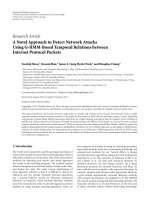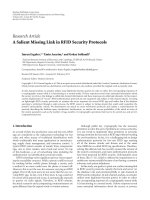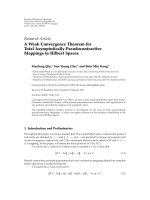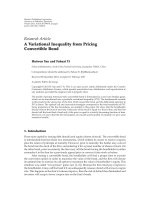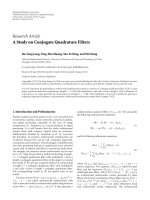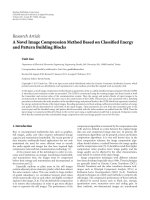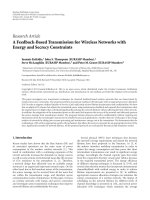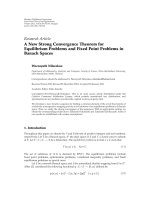Báo cáo hóa học: " Research Article A Generalized Nonlinear Random Equations with Random Fuzzy Mappings in Uniformly Smooth Banach Spaces" potx
Bạn đang xem bản rút gọn của tài liệu. Xem và tải ngay bản đầy đủ của tài liệu tại đây (533.68 KB, 15 trang )
Hindawi Publishing Corporation
Journal of Inequalities and Applications
Volume 2010, Article ID 728452, 15 pages
doi:10.1155/2010/728452
Research Article
A Generalized Nonlinear Random Equations with
Random Fuzzy Mappings in Uniformly Smooth
Banach Spaces
Nawitcha Onjai-Uea
1, 2
and Poom Kumam
1, 2
1
Department of Mathematics, Faculty of Science, King Mongkut’s University of
Technology Thonburi (KMUTT), Bangmod, Bangkok 10140, Thailand
2
Centre of Excellence in Mathematics, CHE, Sriayudthaya Road, Bangkok 10400, Thailand
Correspondence should be addressed to Poom Kumam,
Received 26 July 2010; Accepted 31 October 2010
Academic Editor: Yeol J. E. Cho
Copyright q 2010 N. Onjai-Uea and P. Kumam. This is an open access article distributed under
the Creative Commons Attribution License, which permits unrestricted use, distribution, and
reproduction in any medium, provided the original work is properly cited.
We introduce and study the general nonlinear random H, η-accretive equations with random
fuzzy mappings. By using the resolvent technique for the H, η-accretive operators, we prove
the existence theorems and convergence theorems of the generalized random iterative algorithm
for this nonlinear random equations with random fuzzy mappings in q-uniformly smooth Banach
spaces. Our result in this paper improves and generalizes some known corresponding results in
the literature.
1. Introduction
Fuzzy Set Theory was formalised by Professor Lofti Zadeh at the University of California
in 1965 with a view to reconcile mathematical modeling and human knowledge in
the engineering sciences. The concept of fuzzy sets is incredible wide range of areas,
from mathematics and logics to traditional and advanced engineering methodologies.
Applications are found in many contexts, from medicine to finance, from human factors to
consumer products, and from vehicle control to computational linguistics.
Random variational inequality theories is an important part of random function anal-
ysis. These topics have attracted many scholars and exports due to the extensive applications
of the random problems see, e.g., 1–17. In 1997, Huang 3 first introduced the concept of
random fuzzy mapping and studied the random nonlinear quasicomplementarity problem
for random fuzzy mappings. Further, Huang studied the random generalized nonlinear
variational inclusions for random fuzzy mappings in Hilbert spaces. Ahmad and Baz
´
an 18
2 Journal of Inequalities and Applications
studied a class of random generalized nonlinear mixed variational inclusions for random
fuzzy mappings and constructed an iterative algorithm for solving such random problems.
Very recently, Lan et al. 11, introduced and studied a class of general nonlinear
random multivalued operator equations involving generalized m-accretive mappings in
Banach spaces and an iterative algorithm with errors for this nonlinear random multivalued
operator equations.
Inspired and motivated by recent works in these fields see 2, 13, 14, 18–29,inthis
paper, we introduce and study a class of general nonlinear random equations with random
fuzzy mappings in Banach spaces. By using Chang’s lemma and the resolvent operator
technique for H, η-accretive mapping. We prove the existence and convergence theorems of
the generalized random iterative algorithm for this nonlinear random equations with random
fuzzy mappings in q-uniformly smooth Banach spaces. Our results improve and extend the
corresponding results of recent works.
2. Preliminaries
Throughout this paper, let Ω, A,μ be a complete σ-finite measure space and E be a separable
real Banach space. We denote by BE, ·, · and ·the class of Borel σ-fields in E, the inner
product and the norm on E, respectively. In the sequel, we denote 2
E
,CBE and
H by 2
E
{A : A ∈ E},CBE{A ⊂ E : A is nonempty, bounded and closed} and the Hausdorff
metric on CBE, respectively.
Next, we will use the following definitions and lemmas.
Definition 2.1. An operator x : Ω → E is said to be measurable if, for any B ∈BE, {t ∈ Ω :
xt ∈ B}∈A.
Definition 2.2. A operator F : Ω × E → E is called a random operator if for any x ∈ E, Ft, x
yt is measurable. A random operator F is said to be continuous resp. linear, bounded if for
any t ∈ Ω, the operator Ft, · :
E → E is continuous resp. linear, bounded.
Similarly, we can define a random operator a : Ω × E × E → E. We will write F
t
x
Ft, xt and a
t
x, yat, xt,yt for all t ∈ Ω and xt,yt ∈ E.
It is well known that a measurable operator i s necessarily a random operator.
Definition 2.3. A multivalued operator G : Ω → 2
E
is said to be measurable if, for any B ∈
BE, G
−1
B{t ∈ Ω : Gt ∩ B
/
∅} ∈ A.
Definition 2.4. A operator u : Ω → E is called a measurable selection of a multivalued
measurable operator Γ : Ω → 2
E
if u is measurable and for any t ∈ Ω, ut ∈ Γt.
Lemma 2.5 see 19. Let M : Ω × E → CBE be a H-continuous random multivalued operator.
Then, for any measurable operator x : Ω → E, the multivalued operator M·,x· : Ω → CBE
is measurable.
Lemma 2.6 see 19. Let M, V : Ω × E → CBE be two measurable multivalued operators,
>0 be a constant and x : Ω → E be a measurable selection of M. Then there exists a measurable
selection y : Ω → E of V such that, for any t ∈ Ω
,
x
t
− y
t
≤
1
H
M
t
,V
t
.
2.1
Journal of Inequalities and Applications 3
Definition 2.7. A multivalued operator F : Ω × E → 2
E
is called a random multivalued operator
if, for any x ∈ E, F·,x is measurable. A random multivalued operator F : Ω × E → CBE
is said to be H-continuous if, for any t ∈ Ω, Ft, · is continuous in
H·, ·, where
H·, · is the
Hausdorff metric on CBE defined as follows: for any given A, B ∈ CBE,
H
A, B
max
sup
x∈A
inf
y∈B
d
x, y
, sup
y∈B
inf
x∈A
d
x, y
.
2.2
Let FE be the family of all fuzzy sets over E. A mapping F : E →FE is called a
fuzzy mapping over E.
If F is a fuzzy mapping over E, then Fxdenoted by F
x
is fuzzy set on E,andF
x
y
is the membership degree of the point y in F
x
.LetA ∈FE, α ∈ 0, 1. Then the set
A
α
{
x ∈ E : A
x
≥ α
}
2.3
is called a α-cut set of fuzzy set A.
i A fuzzy mapping F : Ω →FE is called measurable if, for any given α ∈ 0, 1,
F·
α
: Ω → 2
E
is a measurable multivalued mapping.
ii A fuzzy mapping F : Ω × E →FE is called a random fuzzy mapping if, for any
x ∈ E, F·,x : Ω →FE is a measurable fuzzy mapping.
Let K, T, G : Ω × E →FE be three random fuzzy mappings satisfying the following
condition C: there exists three mappings a, b, c : E → 0, 1, such that
K
t,x
ax
∈ CB
E
,
T
t,x
bx
∈ CB
E
,
G
t,x
cx
∈ CB
E
, ∀
t, x
∈ Ω × E. 2.4
By using the random fuzzy mappings K, T and G, we can define the three multivalued
mappings
K,
T and
G as follows, respectively.
K : Ω × E −→ CB
E
,
t, x
−→
K
t,x
ax
, ∀
t, x
∈ Ω × E,
T : Ω × E −→ CB
E
,
t, x
−→
T
t,x
bx
, ∀
t, x
∈ Ω × E,
G : Ω × E −→ CB
E
,
t, x
−→
G
t,x
cx
, ∀
t, x
∈ Ω × E.
2.5
It means that
K
t, x
K
t,x
ax
{
z ∈ E,
K
t,x
z
≥ a
x
}
∈ CB
E
,
T
t, x
T
t,x
bx
{
z ∈ E,
T
t,x
z
≥ b
x
}
∈ CB
E
,
G
t, x
G
t,x
cx
{
z ∈ E,
G
t,x
z
≥ c
x
}
∈ CB
E
.
2.6
It easy to see that
K,
T and
G are the random multivalued mappings. We call
K,
T and
G are
random multivalued mappings induced by fuzzy mappings K, T and G, respectively.
4 Journal of Inequalities and Applications
Suppose that p, S : Ω×E → E and M : Ω×E×E → 2
E
with Imp ∩ domMt, ·,s
/
∅,
H : Ω × E → E and N : Ω × E × E × E → E be two single-valued mappings. Let K, T, G :
Ω×E →FE be three random fuzzy mappings satisfying the condition C. Given mappings
a, b, c : E → 0, 1. Now, we consider the following problem:
Find measurable mappings x, u, v, w : Ω → E such that for all t ∈ Ω, xt ∈ E,
K
t,xt
ut ≥ axt, T
t,xt
vt ≥ bxt, G
t,xt
wt ≥ cxt and
0 ∈ N
t, S
t, x
t
,u
t
,v
t
M
t, p
t, x
t
,w
t
. 2.7
The problem 2.7 is called random variational inclusion problem for random fuzzy mappings in
Banach spaces. The set of measurable mappings x, u, v, w is called a random solution of 2.7.
Some special cases of 2.7:
1 If G is a single-valued operator, p ≡ I, where I is the identity mapping and
Nt, x, y, zft, zgt, x, y for all t ∈ Ω and x, y, z ∈
E, then 2.7 is equivalent to
finding x, v : Ω → E such that vt ∈ Tt, xt and
0 ∈ f
t, v
t
g
t, S
t, x
t
,u
t
M
t, x
t
,G
t, x
t
, 2.8
for all t ∈ Ω and u ∈ Mt, xt. The problem 2.8 was considered and studied by Agarwal
et al. 1, when G ≡ I.
If Mt, x, sMt, x for all t
∈ Ω, x, s ∈ E and, for all t ∈ Ω, Mt, · : E → 2
E
is a
H
t
,η-accretive mapping, then 2.7 reduces to the following generalized nonlinear random
multivalued operator equation involving H
t
,η-accretive mapping in Banach spaces:
Find x, v : Ω → E such that vt ∈ Tt, xt and
0 ∈ N
t, S
t, x
t
,u
t
,v
t
M
t, g
t, x
t
, 2.9
for all t ∈ Ω and ut ∈ Mt, xt.
The generalized duality mapping J
q
: E → 2
E
∗
is defined by
J
q
x
f
∗
∈ E
∗
:
x, f
∗
x
q
,
f
∗
x
q−1
, 2.10
for all x ∈ E, where q>1 is a constant. In particular, J
2
is the usual normalized duality
mapping. It is well known that, in general, J
q
xx
q−2
J
2
x for all x
/
0andJ
q
is single-
valued if E
∗
is strictly convex see, e.g., 29.IfE H is a Hilbert space, then J
2
becomes the
identity mapping of H. In what follows we will denote the single-valued generalized duality
mapping by j
q
.
The modules of smoothness of E is the function ρ
E
: 0, ∞ → 0, ∞ defined by
ρ
E
t
sup
1
2
x y
x − y
− 1:
x
≤ 1,
y
≤ t
. 2.11
A Banach space E is called uniformly smooth if lim
t → 0
ρ
E
t/t0andE is called q-uniformly
smooth if there exists a constant c>0 such that ρ
Et
≤ ct
q
, where q>1 is a real number.
Journal of Inequalities and Applications 5
It is well known that Hilbert spaces, L
p
or l
p
spaces, 1 <p<∞ and the Sobolev spaces
W
m,p
,1<p<∞,areallq-uniformly smooth.
In the study of characteristic inequalities in a q-uniformly smooth Banach space, Xu
30 proved the following result.
Lemma 2.8. Let q>1 be a given real number and E be a real uniformly smooth Banach space. Then
E is q-uniformly smooth if and only if there exists a constant c
q
> 0 such that, for all x, y ∈ E and
j
q
x ∈ J
q
x, the following inequality holds:
x y
q
≤
x
q
q
y, j
q
x
c
q
y
q
.
2.12
Definition 2.9. A random operator p : Ω × E → E is said to be:
a α-strongly accretive if there exists j
2
xt − yt ∈ J
2
xt − yt such that
g
t
x
− g
t
y
,j
2
x
t
− y
t
≥ α
t
x
t
− y
t
2
,
2.13
for all xt,yt ∈ E and t ∈ Ω, where αt > 0 is a real-valued random variable;
b β-Lipschitz continuous if there exists a real-valued random variable βt > 0 such that
g
t
x
− g
t
y
≤ β
t
x
t
− y
t
, 2.14
for all xt,yt ∈ E and t ∈ Ω.
Definition 2.10. Let S : Ω × E → E be a random operator. A operator N : Ω × E × E × E → E
is said to be:
a -strongly accretive with respect to S in the first argument if there exists j
2
xt −
yt ∈ J
2
xt − yt such that
N
t
S
t
x
, ·, ·
− N
t
S
t
y
, ·, ·
,j
2
x
t
− y
t
≥
t
x
t
− y
t
2
,
2.15
for all xt,yt ∈ E and t ∈ Ω, where t > 0 is a real-valued random variable;
b -Lipschitz continuous in the first argument if there exists a real-valued random
variable t > 0 such that
N
t
x, ·, ·
− N
t
y, ·, ·
≤
t
x
t
− y
t
, 2.16
for all xt,yt ∈ E and t ∈ Ω.
Similarly, we can define the Lipschitz continuity in the second argument and third
argument of N·, ·, ·.
6 Journal of Inequalities and Applications
Definition 2.11. Let η : Ω × E × E → E
∗
be a random operator H : Ω × E → E be a random
operator and M : Ω × E → 2
E
be a random multivalued operator. Then M is said to be:
a η-accretive if
u
t
− v
t
,η
t
x, y
≥ 0, 2.17
for all xt,yt ∈ E, ut ∈ M
t
x and vt ∈ M
t
y where M
t
zMt, zt,for
all t ∈ Ω;
b strictly η-accretive if
u
t
− v
t
,η
t
x, y
≥ 0, 2.18
for all xt,yt ∈ E, ut ∈ M
t
x, vt ∈ M
t
y and t ∈ Ω and the equality holds if
and only if utvt for all t ∈ Ω;
c r-strongly η-accretive if there exists a real-valued random variable rt > 0 such that,
for any t ∈ Ω,
u
t
− v
t
,η
t
x, y
≥ r
t
x
t
− y
t
2
,
2.19
for all xt,yt ∈ E, ut ∈ M
t
x, vt ∈ M
t
y and t ∈ Ω.
Definition 2.12. Let η : Ω × E × E → E be a single-valued mapping, A : Ω × E → E be a
single-valued mapping, M : Ω × E → 2
E
be a multivalued mapping.
i M
t
is said to be m-accretive if M
t
is accretive and I ρtMt, ·EE for all t ∈ Ω
and ρt > 0, where I is identity operator on E;
ii M
t
is said to be generalized m-accretive if M
t
is η-accretive and I ρtMt, ·EE
for all t ∈ Ω and ρt > 0;
iii M
t
is said to be H
t
-accretive if M
t
is accretive and H
t
ρtMt, ·EE for all
t ∈ Ω and ρt > 0;
iv M
t
is said to be H
t
,η-accretive if M
t
is η-accretive and H
t
ρtMt, ·EE for
all t ∈ Ω and ρt > 0.
Remark 2.13. If E E
∗
H is a Hilbert space, then a–c of Definition 2.11 reduce to the
definition of η-monotonicity, strict η-monotonicity and strong η-monotonicity, respectively,
if E is uniformly smooth and ηx, yj
2
x − y ∈ J
2
x − y, then a–c of Definition 2.11
reduce to the definitions of accretive, strictly accretive and strongly accretive in uniformly
smooth Banach spaces, respectively.
Definition 2.14. The operator η : Ω × E × E → E
∗
is said to be: τ-Lipschitz continuous if there
exists a real-valued random variable τt > 0 such that
η
t
x, y
≤ τ
t
x
t
− y
t
, 2.20
for all xt,yt ∈ E and t ∈ Ω.
Journal of Inequalities and Applications 7
Definition 2.15. A multivalued measurable operator T : Ω × E → CBE is said to be γ-
H-
Lipschitz continuous if there exists a measurable function γ : Ω → 0, ∞ such that, for any
t ∈ Ω,
H
T
t
x
,T
t
y
≤ γ
t
x
t
− y
t
, 2.21
for all xt,yt ∈ E.
Definition 2.16. Let M : Ω × E × E → 2
E
be a H
t
,η-accretive random operator and H :
Ω × E → E be r-strongly monotone random operator. Then the proximal operator J
ρt,H
t
M
t·,x
is
defined as follows:
J
ρt,H
t
M
t·,x
z
H
t
ρ
t
M
t
−1
z
, 2.22
for all t ∈ Ω and z ∈ E, where ρ : Ω → 0, ∞ is a measurable function and η : Ω×E×E → E
∗
is a strictly monotone operator.
Lemma 2.17 see 31. Let η : E × E → E be a τ-Lipschitz continuous operator, H : Ω × E → E
be a r-strongly η-accretive operator and M : Ω × E → 2
E
be an H
t
,η-accretive operator. Then, the
proximal operator J
ρt,H
t
M
t
: E → E is τ
q−1
/r-Lipschitz continuous, that is,
J
ρt,H
t
M
t
x
− J
ρt,H
t
M
t
y
≤
τ
q−1
r
x − y
, ∀x, y ∈ E, t ∈ Ω. 2.23
3. Random Iterative Algorithms
In this section, we suggest and analyze a new class of iterative methods and construct some
new random iterative algorithms for solving 2.7.
Lemma 3.1. The set of measurable mapping x, u, v, w : Ω → E a random solution of problem 2.7
if and only if for all t ∈ Ω, and
p
t
x
J
ρt,H
t
M
t·,w
H
t
p
t
x
− ρ
t
N
t
S
t
x
,u,v
. 3.1
Proof. The proof directly follows from the definition of J
ρt,H
t
M
t·,w
as follows:
p
t
x
J
ρt,H
t
M
t·,w
H
t
p
t
x
− ρ
t
N
t
S
t
x
,u,v
⇐⇒ p
t
x
H
t
ρ
t
M
t
−1
H
t
p
t
x
− ρ
t
N
t
S
t
x
,u,v
⇐⇒ H
t
p
t
x
− ρ
t
N
t
S
t
x
,u,v
∈ H
t
p
t
x
ρ
t
M
t
p
t
x
,w
⇐⇒ 0 ∈ M
t
p
t
x
,w
N
t
S
t
x
,u,v
.
3.2
8 Journal of Inequalities and Applications
Algorithm 3.2. Suppose that K, T, G : Ω × E →FE be three random fuzzy mappings
satisfying the condition C.Let
K,
T,
G : Ω × E → CBE be
H-continuous random
multivalued mappings induced by K, T,andG, respectively. Let S, p : Ω × E → E,
η : Ω × E × E → E and N : Ω × E × E × E → E be random single-valued
operators. Let M : Ω × E × E → 2
E
be a random multivalued operator such that for
each fixed t ∈ Ω and s ∈ E, Mt, ·,s : E → 2
E
be a H
t
,η-accretive mapping
and Rangep
dom Mt, ·,s
/
∅. For any given measurable mapping x
0
: Ω → E,
the multivalued mappings
K·,x
0
·,
T·,x
0
·,
G·,x
0
· : Ω → E are measurable by
Lemma 2.5. Then, there exists measurable selections u
0
· ∈
K·,x
0
·,v
0
· ∈
T·,x
0
· and
w
0
· ∈
G·,x
0
· by Himmelberg 6.Set
x
1
t
x
0
t
− λ
t
p
t
x
0
− J
ρt,H
t
M
t
·,w
0
H
t
p
t
x
0
− ρ
t
N
t
S
t
x
0
,u
0
,v
0
, 3.3
where λtρt and H
t
are the same as in Lemma 3.1. Then it is easy to know that x
1
: Ω → E
is measurable. Since u
0
t ∈
K
t
x
0
∈ CBE,v
0
t ∈
T
t
x
0
∈ CBE and w
0
t ∈
G
t
x
0
∈
CBE,byLemma 2.6, there exist measurable selections u
1
t ∈
K
t
x
1
,v
1
t ∈
T
t
x
1
and
w
1
t ∈
G
t
x
1
such that for all t ∈ Ω,
u
0
t
− u
1
t
≤
1
1
1
H
K
t
x
0
,
K
t
x
1
,
v
0
t
− v
1
t
≤
1
1
1
H
T
t
x
0
,
T
t
x
1
,
w
0
t
− w
1
t
≤
1
1
1
H
G
t
x
0
,
G
t
x
1
.
3.4
By induction, we can define the sequences {x
n
t}, {u
n
t}, {v
n
t} and {w
n
t} inductively
satisfying
x
n1
t
x
n
t
− λ
t
p
t
x
n
− J
ρt,H
t
M
t·,w
n
H
t
p
t
x
n
− ρ
t
N
t
S
t
x
n
,u
n
,v
n
,
u
n
t
∈
M
t
x
n
,
u
n
t
− u
n1
t
≤
1
1
n 1
H
K
t
x
n
,
K
t
x
n1
,
v
n
t
∈
T
t
x
n
,
v
n
t
− v
n1
t
≤
1
1
n 1
H
T
t
x
n
,
T
t
x
n1
,
w
n
t
∈
G
t
x
n
,
w
n
t
− w
n1
t
≤
1
1
n 1
H
G
t
x
n
,
G
t
x
n1
.
3.5
From Algorithm 3.2 , we can get the following algorithms.
Journal of Inequalities and Applications 9
Algorithm 3.3. Suppose that E, M, η, S,
K,
T and λ are the same as in Algorithm 3.2.Let
G : Ω × E → E be a random single-valued operator, p ≡ I and Nt, x, y, zft, zgt, x, y
for all t ∈ Ω and x, y, z ∈ E. Then, for given measurable x
0
: Ω → E, we have
x
n1
t
1 − λ
t
x
n
t
λ
t
J
ρt,H
t
M
t·,G
t
x
n
x
n
t
− ρ
t
f
t
v
n
g
t
S
t
x
n
,u
n
,
u
n
t
∈
K
t
x
n
,
u
n
t
− u
n1
t
≤
1
1
n 1
H
K
t
x
n
,
K
t
x
n1
,
v
n
t
∈
T
t
x
n
,
v
n
t
− v
n1
t
≤
1
1
n 1
H
T
t
x
n
,
T
t
x
n1
.
3.6
Algorithm 3.4. Let M : Ω×E → 2
E
be a random multivalued operator such that for each fixed
t ∈ Ω, Mt, · : E → 2
E
is a H, η-accretive mapping and Rangep
dom Mt, ·
/
∅.IfS, p,
η, N,
K,
T and λ are the same as in Algorithm 3.2, then for given measurable x
0
: Ω → E,
we have
x
n1
t
x
n
t
− λ
t
p
t
x
n
− J
ρt,H
t
M
t·,w
n
p
t
x
n
− ρ
t
N
t
S
t
x
n
,u
n
,v
n
,
u
n
t
∈
K
t
x
n
,
u
n
t
− u
n1
t
≤
1
1
n 1
H
K
t
x
n
,
K
t
x
n1
,
v
n
t
∈
T
t
x
n
,
v
n
t
− v
n1
t
≤
1
1
n 1
H
T
t
x
n
,
T
t
x
n1
.
3.7
4. Existence and Convergence Theorems
In this section, we prove the existence and convergence theorems of the generalized random
iterative algorithm for this nonlinear random equations with random fuzzy mappings in q-
uniformly smooth Banach spaces.
Theorem 4.1. Suppose that E is a q-uniformly smooth and separable real Banach space, p : Ω ×E →
E is α-strongly accretive and β-Lipschitz continuous, η : Ω × E × E → E be τ-Lipschitz continuous,
H : Ω × E → E is r-strongly η-accretive and μ
A
-Lipschitz continuous and M : Ω × E × E → 2
E
is a random multivalued operator such that for each fixed t ∈ Ω and s ∈ E, Mt, ·,s : E → 2
E
is a
H
t
,η-accretive mapping and Rangep
dom Mt, ·,s
/
∅.LetS : Ω × E → E be a σ-Lipschitz
continuous random operator and N : Ω × E × E × E → E be -Lipschitz continuous in the first
argument, μ-Lipschitz continuous in the second argument and ν-Lipschitz continuous in the third
argument, respectively. Let K, T, G : Ω × E →FE be three random fuzzy mappings satisfying the
condition (C),
K,
T,
G : Ω × E → CBE be three random multivalued mappings induced by the
mappings K, T, G, respectively, K, T and G are
H-Lipschitz continuous with constants μ
K
t, μ
T
t
and μ
G
t, respectively. If for each real-valued random variables ρt > 0 and πt > 0 such that, for
any t ∈ Ω, x, y, z ∈ E,
J
ρt,H
t
M
t·,x
z
− J
ρt,H
t
M
t·,y
z
≤ π
t
x − y
4.1
10 Journal of Inequalities and Applications
and the following conditions hold:
l
t
1 − qαtc
q
β
t
q
1/q
π
t
μ
G
t
< 1,
μ
A
t
β
t
ρ
t
t
σ
t
μ
t
μ
K
t
ν
t
μ
T
t
<
r
t
1 − l
t
τ
t
q−1
,
4.2
where c
q
isthesameasinLemma 2.8 for any t ∈ Ω. If there exist real-valued random variables
λt,ρt > 0 then there exist x
∗
t ∈ E, u
∗
t ∈ K
t
x
∗
,v
∗
t ∈ T
t
x
∗
and w
∗
t ∈ G
t
x
∗
such
that x
∗
t,u
∗
t,v
∗
t,w
∗
t is solution of 2.7 and
x
n
t
−→ x
∗
t
,u
n
t
−→ u
∗
t
,v
n
t
−→ v
∗
t
,w
n
t
−→ w
∗
t
4.3
as n →∞,where{x
n
t}, {u
n
t}, {v
n
t} and {w
n
t} are iterative sequences generated by
Algorithm 3.2.
Proof. From Algorithm 3.2, Lemma 2.17 and 4.1, we compute
x
n1
t
− x
n
t
x
n
t
− λ
t
p
t
x
n
− J
ρt,H
t
M
t·,w
n
H
t
p
t
x
n
− ρ
t
N
t
S
t
x
n
,u
n
,v
n
− x
n−1
t
λ
t
p
t
x
n−1
− J
ρt,H
t
M
t·,w
n−1
H
t
p
t
x
n−1
− ρ
t
N
t
S
t
x
n−1
,u
n−1
,v
n−1
≤
x
n
t
− x
n−1
t
− λ
t
p
t
x
n
− p
t
x
n−1
λ
t
J
ρt,H
t
M
t·,w
n
H
t
p
t
x
n
− ρ
t
N
t
S
t
x
n
,u
n
,v
n
− J
ρt,H
t
M
t·,w
n−1
H
t
p
t
x
n−1
− ρ
t
N
t
S
t
x
n−1
,u
n−1
,v
n−1
≤
x
n
t
− x
n−1
t
− λ
t
p
t
x
n
− p
t
x
n−1
λ
t
J
ρt,H
t
M
t·,w
n
H
t
p
t
x
n
− ρ
t
N
t
S
t
x
n
,u
n
,v
n
− J
ρt,H
t
M
t·,w
n
H
t
p
t
x
n−1
− ρ
t
N
t
S
t
x
n−1
,u
n−1
,v
n−1
λ
t
J
ρt,H
t
M
t·,w
n
H
t
p
t
x
n−1
− ρ
t
N
t
S
t
x
n−1
,u
n−1
,v
n−1
− J
ρt,H
t
M
t·,w
n−1
H
t
p
t
x
n−1
− ρ
t
N
t
S
t
x
n−1
,u
n−1
,v
n−1
≤
x
n
t
− x
n−1
t
− λ
t
p
t
x
n
− p
t
x
n−1
λ
t
τ
t
q−1
r
t
H
t
p
t
x
n
− ρ
t
N
t
S
t
x
n
,u
n
,v
n
−
H
t
p
t
x
n−1
− ρ
t
N
t
S
t
x
n−1
,u
n−1
,v
n−1
λ
t
π
t
w
n
− w
n−1
Journal of Inequalities and Applications 11
≤
1 − λ
t
x
n
t
− x
n−1
t
λ
t
x
n
t
− x
n−1
t
−
p
t
x
n
− p
t
x
n−1
λ
t
τ
t
q−1
r
t
H
t
p
t
x
n
− H
t
p
t
x
n−1
ρ
t
N
t
S
t
x
n
,u
n
,v
n
− N
t
S
t
x
n−1
,u
n
,v
n
ρ
t
N
t
S
t
x
n−1
,u
n
,v
n
− N
t
S
t
x
n−1
,u
n−1
,v
n
ρ
t
N
t
S
t
x
n−1
,u
n−1
,v
n
− N
t
S
t
x
n−1
,u
n−1
,v
n−1
λ
t
π
t
w
n
− w
n−1
.
4.4
By using p
t
is a strongly accretive and Lipschitz continuous, we have
x
n
t − x
n−1
t −
p
t
x
n
− p
t
x
n−1
q
≤
x
n
t − x
n−1
t
q
− q
p
t
x
n
− p
t
x
n−1
,j
q
x
n
t
− x
n−1
t
c
q
p
t
x
n
− p
t
x
n−1
q
≤
1 − qα
t
c
q
β
t
q
x
n
t − x
n−1
t
q
,
4.5
that is
x
n
t
− x
n−1
t
−
p
t
x
n
− p
t
x
n−1
≤
1 − qα
t
c
q
β
t
q
1/q
x
n
t
− x
n−1
t
,
4.6
where c
q
is the same as in Lemma 2.8.
By Lipschitz continuity of N in the first, second and third argument, S, p, H is σ-
Lipschitz continuous, β-Lipschitz continuous, μ
A
-Lipschitz continuous, respectively, and
K,
T,and
G are H-Lipschitz continuous, we have
N
t
S
t
x
n
,u
n
,v
n
− N
t
S
t
x
n−1
,u
n
,v
n
≤
t
S
t
x
n
− S
t
x
n−1
≤
t
σ
t
x
n
t
− x
n−1
t
,
N
t
S
t
x
n−1
,u
n
,v
n
− N
t
S
t
x
n−1
,u
n−1
,v
n
≤ μ
t
u
n
− u
n−1
≤ μ
t
1
1
n
H
K
t
x
n−1
,
K
t
x
n
≤
1
1
n
μ
t
μ
K
t
x
n
t
− x
n−1
t
,
12 Journal of Inequalities and Applications
N
t
S
t
x
n−1
,u
n−1
,v
n
− N
t
S
t
x
n−1
,u
n−1
,v
n−1
≤ ν
t
v
n
− v
n−1
≤ ν
t
1
1
n
H
T
t
x
n−1
,
T
t
x
n
≤
1
1
n
ν
t
μ
T
t
x
n
t
− x
n−1
t
,
H
t
p
t
x
n
− H
t
p
t
x
n−1
≤ μ
A
t
p
t
x
n
− p
t
x
n−1
≤ μ
A
t
β
t
x
n
t
− x
n−1
t
,
w
n
− w
n−1
≤
1
1
n
H
G
t
x
n−1
,
G
t
x
n
≤
1
1
n
μ
G
t
x
n
t
− x
n−1
t
.
4.7
Using 4.6–4.7 in 4.4, we obtain for all t ∈ Ω,
x
n1
t
− x
n
t
≤ θ
n
t
x
n
t
− x
n−1
t
, 4.8
where
θ
n
t
1 − λ
t
λ
t
κ
n
t
,
κ
n
t
1 − qα
t
c
q
β
t
q
1/q
1
1
n
π
t
μ
G
t
τ
t
q−1
r
t
μ
A
t
β
t
ρ
t
t
σ
t
ρ
t
1
1
n
μ
t
μ
K
t
ν
t
μ
T
t
.
4.9
Letting
κ
t
1 − qα
t
c
q
β
t
q
1/q
π
t
μ
G
t
τ
t
q−1
r
t
μ
A
t
β
t
ρ
t
t
σ
t
μ
t
μ
K
t
ν
t
μ
T
t
,
θ
t
1 − λ
t
λ
t
κ
t
.
4.10
Thus κ
n
t → κt, θ
n
t → θt as n →∞.From4.2, we know that 0 <θt < 1, for
all t ∈ Ω. Using the same arguments as those used in the proof of Lan et al. 11, Theorem
Journal of Inequalities and Applications 13
3.1, page 14 it follows that {x
n
t}, {u
n
t}, {v
n
t} and {w
n
t} are Cauchy sequences. T hus
by the completeness of E, there exist u
∗
t,v
∗
t,w
∗
t ∈ E such that u
n
t → u
∗
t,v
n
t →
v
∗
t,w
n
t → w
∗
t as n →∞.
Next, we show that u
∗
t ∈ K
t
x
∗
, we have
d
u
∗
t
,K
t
x
∗
inf
u
∗
t
− y
: y ∈ K
t
x
∗
≤
u
∗
t
− u
n
t
d
u
n
t
,K
t
x
∗
≤
u
∗
t
− u
n
t
H
K
t
x
n
,K
t
x
∗
≤
u
∗
t
− u
n
t
μ
K
t
x
n
t
− x
∗
t
−→ 0,n−→ ∞ .
4.11
This implies that u
∗
t ∈ K
t
x
∗
. Similarly, we can get v
∗
t ∈ T
t
x
∗
and w
∗
t ∈ G
t
x
∗
for all
t ∈ Ω. Therefore, from Algorithm 3.2 and the continuity of J
ρt,H
t
M
t·,w
, p, N and S,weobtain
p
t
x
J
ρt,H
t
M
t·,w
H
t
p
t
x
− ρ
t
N
t
S
t
x
,u,v
.
4.12
By Lemma 3.1,weknowthatx
∗
t,u
∗
t,v
∗
t,w
∗
t is a solution of 2.7. This completes
the proof.
Remark 4.2. If the fuzzy mapping K, T and G are multivalued operators, H
t
≡ I,and
multivalued M is generalized m-accretive mapping, η is δ-strongly monotone, N is -
strongly accretive with respect to S, then the result is Theorem 3.1 of Lan et al. 11.
From Theorem 4.1, we can get the following theorems.
Theorem 4.3. Let E, η, S, H
t
,
K,
T and λ are the same as in Theorem 4.1. Assume that M : Ω × E ×
E → 2
E
is a random multivalued operator such that, for each fixed t ∈ Ω and s ∈ E, Mt, ·,s : E →
2
E
is a H
t
,η-accretive mapping. Let f : Ω × E → E be ν-Lipschitz continuous, S : Ω × E → E
be a σ-Lipschitz continuous random operator,
G : Ω × E → E be μ
G
-Lipschitz continuous and
g : Ω × E × E → E be -Lipschitz continuous in the first argument and μ-Lipschitz continuous in
the second argument, respectively. If there exist real-valued random variables ρt > 0 and πt > 0
such that 4.13 holds:
1 ρ
t
t
σ
t
μ
t
μ
K
t
ν
t
μ
T
t
<
r
t
1 − π
t
μ
G
t
τ
t
q−1
4.13
for all t ∈ Ω,wherec
q
isthesameasinLemma 2.8, for any t ∈ Ω, the iterative sequences {x
n
t},
{u
n
t} and {v
n
t} defined by Algorithm 3.3 converge strongly to the solution x
∗
t,u
∗
t,v
∗
t
of 2.8.
Theorem 4.4. Suppose that E, p, S, η, N, M, T and λ are the same as in Algorithm 3.2 Let M :
Ω × E → 2
E
be a random multivalued operator such that, for each fixed t ∈ Ω, Mt, · : E → 2
E
14 Journal of Inequalities and Applications
is a H
t
,η-accretive mapping and Rangep
dom Mt, ·
/
∅. If there exists a real-valued random
variable ρt > 0 such that, for any t ∈ Ω, and the following conditions hold:
l
t
1 − qα
t
c
q
β
t
q
1/q
< 1,
μ
A
t
β
t
ρ
t
t
σ
t
μ
t
μ
K
t
ν
t
μ
T
t
<
r
t
1 − l
t
τ
t
q−1
,
4.14
where c
q
isthesameasinLemma 2.8, for any t ∈ Ω, the iterative sequences {x
n
t}, {u
n
t} and
{v
n
t} defined by Algorithm 3.4 converge strongly to the solution x
∗
t,u
∗
t,v
∗
t of 2.9.
Remark 4.5. We note that for suitable choices of the mappings S, p, H, M, K, T, G, η and space
E. Theorems 4.1–4.4 reduces to many known results of generalized variational inclusions as
special cases see 1, 3, 4, 20–25, 32 and the references therein.
Acknowledgments
This research is supported by the “Centre of Excellence in Mathematics”, the Commission on
High Education, Thailand. Moreover, N. Onjai-Uea is supported by the “Centre of Excellence
in Mathematics”, the Commission on High Education, Thailand for Ph.D. Program at King
Mongkuts University of Technology Thonburi KMUTT.
References
1 R. P. Agarwal, Y. J. Cho, and N J. Huang, “Generalized nonlinear variational inclusions involving
maximal η-monotone mappings,” in Nonlinear Analysis and Applications: To V. Lakshmikantham on His
80th Birthday, vol. 1, 2, pp. 59–73, Kluwer Academic Publishers, Dordrecht, The Netherlands, 2003.
2 R. P. Agarwal, M. F. Khan, D. O’Regan, and Salahuddin, “On generalized multivalued nonlinear
variational-like inclusions w ith fuzzy mappings,” Advances in Nonlinear Variational Inequalities, vol. 8,
no. 1, pp. 41–55, 2005.
3 N J. Huang, “Generalized nonlinear variational inclusions with noncompact valued mappings,”
Applied Mathematics Letters, vol. 9, no. 3, pp. 25–29, 1996.
4 N J. Huang and Y P. Fang, “A new class of general variational inclusions involving maximal η-
monotone mappings,” Publicationes Mathematicae Debrecen, vol. 62, no. 1-2, pp. 83–98, 2003.
5 N J. Huang, Y. P. Fang, and C. X. Deng, “Nonlinear variational inclusions involving generalized
m-accretive mappings,” in Proceedings of the Bellman Continuum: International Workshop on Uncertain
Systems and Soft Computing, pp. 323–327, Beijing, China, July 2002.
6 C. J. Himmelberg, “Measurable relations,” Fundamenta Mathematicae, vol. 87, pp. 53–72, 1975.
7 N J. Huang, “Nonlinear implicit quasi-variational inclusions involving generalized m-accretive
mappings,” Archives of Inequalities and Applications, vol. 2, no. 4, pp. 413–425, 2004.
8 H Y. Lan, “Projection iterative approximations for a new class of general random implicit quasi-
variational inequalities,” Journal of Inequalities and Applications, vol. 2006, Article ID 81261, 17 pages,
2006.
9 H Y. Lan, “Approximation solvability of nonlinear random A, η-resolvent operator equations with
random relaxed cocoercive operators,” Computers & Mathematics with Applications, vol. 57, no. 4, pp.
624–632, 2009.
10 H Y. Lan, “A class of nonlinear A, η-monotone operator inclusion problems with relaxed cocoercive
mappings,” Advances in Nonlinear Variational Inequalities, vol. 9, no. 2, pp. 1–11, 2006.
11 H Y. Lan, Y. J. Cho, and W. Xie, “General nonlinear random equations with random multivalued
operator in Banach spaces,” Journal of Inequalities and Applications, vol. 2009, Article ID 865093, 17
pages, 2009.
Journal of Inequalities and Applications 15
12 M M. Jin and Q K. Liu, “Nonlinear quasi-variational inclusions involving generalized m-accretive
mappings,” Nonlinear Functional Analysis and Applications, vol. 9, no. 3, pp. 485–494, 2004.
13 H. Y. Lan, J. K. Kim, and N J. Huang, “On the generalized nonlinear quasi-variational inclusions
involving non-monotone set-valued mappings,” Nonlinear Functional Analysis and Applications, vol. 9,
no. 3, pp. 451–465, 2004.
14 H Y. Lan, Q K. Liu, and J. Li, “Iterative approximation for a system of nonlinear variational
inclusions involving generalized m-accretive mappings,” Nonlinear Analysis Forum, vol. 9, no. 1, pp.
33–42, 2004.
15 H Y. Lan, Z Q. He, and J. Li, “Generalized nonlinear fuzzy quasi-variational-like inclusions
involving maximal η-monotone mappings,” Nonlinear Analysis Forum, vol. 8, no. 1, pp. 43–54, 2003.
16 L W. Liu and Y Q. Li, “On generalized set-valued variational inclusions,” Journal of Mathematical
Analysis and Applications, vol. 261, no. 1, pp. 231–240, 2001.
17 R. U. Verma, M. F. Khan, and Salahuddin, “Generalized setvalued nonlinear mixed quasivariational-
like inclusions with fuzzy mappings,” Advances in Nonlinear Variational Inequalities,vol.8,no.2,pp.
11–37, 2005.
18 R. Ahmad and F. F. Baz
´
an, “An iterative algorithm for random generalized nonlinear mixed
variational inclusions for random fuzzy mappings,” Applied Mathematics and Computation, vol. 167,
no. 2, pp. 1400–1411, 2005.
19 S. S. Chang, Fixed Point Theory with Applications, Chongqing, Chongqing, China, 1984.
20 S. S. Chang, Variational Inequality and Complementarity Problem Theory with Applications, Shanghai
Scientific and Technological Literature, Shanghai, China, 1991.
21 S. S. Chang and N J. Huang, “Generalized random multivalued quasi-complementarity problems,”
Indian Journal of Mathematics, vol. 35, no. 3, pp. 305–320, 1993.
22 Y. J. Cho, S. H. Shim, N J. Huang, and S. M. Kang, “Generalized strongly nonlinear implicit quasi-
variational inequalities for fuzzy mappings,” in Set Valued Mappings with Applications in Nonlinear
Analysis, vol. 4 of Mathematical Analysis and Applications, pp. 63–77, Taylor & Francis, London, UK,
2002.
23 Y. J. Cho, N J. Huang, and S. M. Kang, “Random generalized set-valued strongly nonlinear implicit
quasi-variational inequalities,” Journal of Inequalities and Applications, vol. 5, no. 5, pp. 515–531, 2000.
24
Y. J. Cho and H Y. Lan, “Generalized nonlinear random A, η-accretive equations with random
relaxed cocoercive mappings in Banach spaces,” Computers & Mathematics with Applications, vol. 55,
no. 9, pp. 2173–2182, 2008.
25 H. R. Feng and X. P. Ding, “A new system of generalized nonlinear quasi-variational-like inclusions
with A-monotone operators in Banach spaces,” Journal of Computational and Applied Mathematics,vol.
225, no. 2, pp. 365–373, 2009.
26 N J. Huang and Y. J. Cho, “Random completely generalized set-valued implicit quasi-variational
inequalities,” Positivity, vol. 3, no. 3, pp. 201–213, 1999.
27 N J. Huang, X. Long, and Y. J. Cho, “Random completely generalized nonlinear variational inclusions
with non-compact valued random mappings,” Bulletin of the Korean Mathematical Society, vol. 34, no.
4, pp. 603–615, 1997.
28 M. A. Noor and S. A. Elsanousi, “Iterative algorithms for random variational inequalities,”
Panamerican Mathematical Journal, vol. 3, no. 1, pp. 39–50, 1993.
29 R. U. Verma, “A class of projection-contraction methods applied to monotone variational inequali-
ties,” Applied Mathematics Letters, vol. 13, no. 8, pp. 55–62, 2000.
30 H. K. Xu, “Inequalities in Banach spaces with applications,” Nonlinear Analysis: Theory, Methods &
Applications, vol. 16, no. 12, pp. 1127–1138, 1991.
31 R. Ahmad and A. P. Farajzadeh, “On random variational inclusions with random fuzzy mappings
and random relaxed cocoercive mappings,” Fuzzy Sets and Systems, vol. 160, no. 21, pp. 3166–3174,
2009.
32 N J. Huang, “Random generalized nonlinear variational inclusions for random fuzzy mappings,”
Fuzzy Sets and Systems, vol. 105, no. 3, pp. 437–444, 1999.

